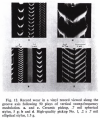Soandso
Senior Member
- Joined
- May 30, 2022
- Messages
- 400
- Likes
- 1,092
Considering repeated occurrences of what our eye's interpret as "damage' it seems, to me, those may actually be intentional imprinting for audio playback reasons which we don't immediately understand. At this time I am not ready to suggest what function the sections of those markings might serve.Here are the first images with the new system. Arrival, last song on side 2 of Abba's Arrival album. Has good HF content. You can see the first quiet groove on the bottom in 2D, on left in 3D images.
I'm seeing the same type of "damage" as I saw on the previous album. I bought this album new back in 1978, and I am the only one who has played, it, but it has been played on a bunch of different systems with dubious stylus qualities. The first album I showed with this "damage" was purchased as NM from a record store about 2 weeks ago, so this is not an isolated phenom.
View attachment 290011
View attachment 290014
View attachment 290015
View attachment 290016
Furthermore, the way those markings appear to be "damage" may in some way be artifacts of light scattering from variability of their immediate surface angles relative to the fixed angle of the photographing lens. I have seen published record groove microscope pictures where the author shows photographic variation depending on incident angle; although none of those done at the extreme OP magnification.

